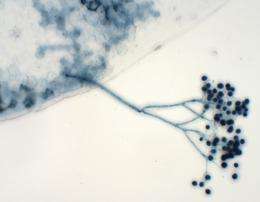Immune defense revs for morning attack

(PhysOrg.com) -- Timing is everything in the long-standing arms race between the flowering plant Arabidopsis and its pathogen, Hyaloperonospora, a downy mildew.
Duke University researchers have found that the little mustard plant cranks up its immune system in the morning to prepare for the greatest onslaught of infectious spores released by the mildew.
It isn't news that plants know what time of day it is and change their activities accordingly, but this is the first time that a plant's defensive systems have been shown to cycle on a daily basis – even when pathogens aren't present. Their work appears in the Feb. 3 edition of Nature.
The powerful chemical compounds Arabidopsis uses to fight mildew infection are expensive to make and also potentially harmful to the plant itself over the long-term, so a daily, or circadian, cycle of production is safer and more efficient than simply having the chemicals on hand all the time, said Duke biology professor Xinnian Dong.
Morning, just as the dew dries, is the right time to have defenses at the ready.
When the mildew has been able to successfully set up housekeeping within Arabidopsis, it produces a flowering body that grows upward from the leaf surface. Bearing its spores for the next generation, it looks very much like a tree covered with apples. As the morning dew dries from the leaf, the mildew's flowering body twists violently, flinging the tiny spores in all directions to be carried on air currents until they settle on a potential new host.
Other researchers who have collected the spores had noted that the morning was the most productive time to catch them, but Arabidopsis apparently already knew that.
Dong and her graduate students Wei Wang and Jinyoung Barnaby discovered this surprising circadian clock connection during a more general search of Arabidopsis immune system genes. They found 22 candidate genes that were a part of the immune response to downy mildew and many of them showed rhythmic expression patterns.
Wang also watched expression patterns of these defense genes in the absence of any pathogens and found them cycling daily. "It suggests that the plants are programmed to anticipate infection according to a circadian schedule," Dong said.
To test this hypothesis, Wang exposed plants to the mildew spores at “dawn” or "dusk" in a greenhouse with artificial 12-hour days. He found infection rates were much higher at dusk when spores were not expected in nature.
To identify the clock components that control this immune defense, Wang began a series of experiments on so-called "clock mutants," which are Arabidopsis plants that lack portions of the circadian time-keeping system. He found that the mutant missing the central clock component CCA1 suffered much higher infection rates than normal plants. Conversely, a plant line expressing CCA1 all the time had heightened resistance.
Over the last decade, plant researchers have identified several systems that work on a circadian clock, including starch metabolism, photosynthesis and frost-resistance, said Robert McClung, a Dartmouth University biologist who was not involved in this research, but is writing an accompanying commentary on the paper for Nature. "This sort of completes the suite of environmental insults that the clock manages," he said.
Although this finding is specific so far to Arabadopsis and its exclusive pathogen Hyaloperonospora, it's likely to be a system that will be found in other plants and pathogens, McClung said.
While it makes logical sense that clock mechanisms would be involved with the plant's immune system, this is still "a remarkable discovery," said Philip Benfey, the Paul Kramer professor of biology at Duke. "This required an experimental tour de force combined with inspired insight to make the connection between gene expression patterns and preparation for pathogen attack."
"It was a huge amount of work, even though the conclusion is quite simple," Dong said.
More information: "Timing of Plant Immune Responses by a Central Circadian Regulator," Wei Wang, et al. Nature, 3 February, 2011. DOI:10.1038/nature09766
Provided by Duke University

















